Absalom
SWCA Member, Absent Comrade
We recently had a thread on the FN 1922. A few days ago I acquired one with a provenance I’d been interested in for awhile.
Anthony Vanderlinden, THE expert on FN Browning handguns, devoted over 40 pages of his book just to the different contract versions of the 1922.
The most commonly found version is the one made under Nazi occupation from 1940 to 1944. The Nazis supervised production of about 450,000 pistols for the Wehrmacht, as well as for commercial sale. My interest, however, is more in post-war police pistols.
When the Western occupation authorities in Germany after 1945 organized new “de-nazified” police forces, these were initially simply armed with Allied surplus, such as the well-known Victory models that can frequently be found with German police markings.
But even after the founding of West Germany in 1949, there were still Allied restrictions on production and issuance. Handguns had to be procured abroad and had to be marked in specified ways.
So much for the background. Now to the specifics of my gun:
In the late 1940s the US authorities procured several thousand FN 1922’s to arm the German railroad police (Bahnpolizei) in their occupation zone, and had them marked accordingly, possibly at the factory (see picture 4). Ironically, by the time they were delivered, the US zone as such didn’t exist anymore, and the pistols were sold to the new federal railroad agency covering all of West Germany, where they entered service in 1951.
Most West German police forces replaced their foreign pistols with German-branded ones, usually the Walther PP/PPK, once these became available. But the Bahnpolizei apparently didn’t see the need; while the FN was technically one generation earlier than the Walthers, it was rugged, reliable, and used the same ammo, so why switch?
The FN 1922 remained the Bahnpolizei’s standard sidearm until it was replaced by the SigSauer P6 in 1978/79.
A batch was imported to the US by an outfit called E.S.I. in Milford NH. At least based on my internet efforts, importing these seems to be the only thing this company ever did; then they either changed their name or evaporated; not a trace to be found.
Anthony Vanderlinden, THE expert on FN Browning handguns, devoted over 40 pages of his book just to the different contract versions of the 1922.
The most commonly found version is the one made under Nazi occupation from 1940 to 1944. The Nazis supervised production of about 450,000 pistols for the Wehrmacht, as well as for commercial sale. My interest, however, is more in post-war police pistols.
When the Western occupation authorities in Germany after 1945 organized new “de-nazified” police forces, these were initially simply armed with Allied surplus, such as the well-known Victory models that can frequently be found with German police markings.
But even after the founding of West Germany in 1949, there were still Allied restrictions on production and issuance. Handguns had to be procured abroad and had to be marked in specified ways.
So much for the background. Now to the specifics of my gun:
In the late 1940s the US authorities procured several thousand FN 1922’s to arm the German railroad police (Bahnpolizei) in their occupation zone, and had them marked accordingly, possibly at the factory (see picture 4). Ironically, by the time they were delivered, the US zone as such didn’t exist anymore, and the pistols were sold to the new federal railroad agency covering all of West Germany, where they entered service in 1951.
Most West German police forces replaced their foreign pistols with German-branded ones, usually the Walther PP/PPK, once these became available. But the Bahnpolizei apparently didn’t see the need; while the FN was technically one generation earlier than the Walthers, it was rugged, reliable, and used the same ammo, so why switch?
The FN 1922 remained the Bahnpolizei’s standard sidearm until it was replaced by the SigSauer P6 in 1978/79.
A batch was imported to the US by an outfit called E.S.I. in Milford NH. At least based on my internet efforts, importing these seems to be the only thing this company ever did; then they either changed their name or evaporated; not a trace to be found.
Attachments
-
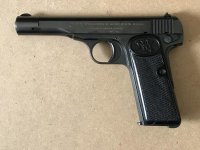 88361A62-F3A4-46E5-9C4F-77423D8ED1D9.jpg77.3 KB · Views: 214
88361A62-F3A4-46E5-9C4F-77423D8ED1D9.jpg77.3 KB · Views: 214 -
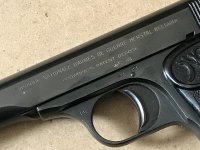 FDF0FC11-F401-4331-9A40-51382890D191.jpg65.6 KB · Views: 171
FDF0FC11-F401-4331-9A40-51382890D191.jpg65.6 KB · Views: 171 -
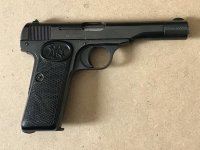 E02B0634-7261-4CC4-B585-1AB2483D377B.jpg76.3 KB · Views: 162
E02B0634-7261-4CC4-B585-1AB2483D377B.jpg76.3 KB · Views: 162 -
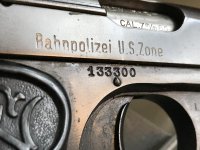 1C48D1DA-7ECB-465A-AFC9-0564532607A3.jpg72.3 KB · Views: 190
1C48D1DA-7ECB-465A-AFC9-0564532607A3.jpg72.3 KB · Views: 190 -
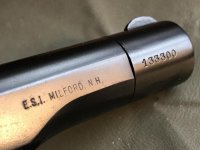 C057D149-155D-409F-AAE8-030633D84EF2.jpg47.8 KB · Views: 170
C057D149-155D-409F-AAE8-030633D84EF2.jpg47.8 KB · Views: 170

